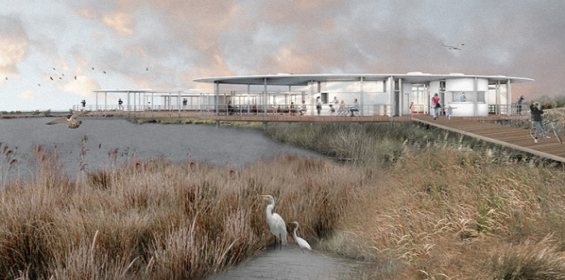Design for a building that absorbs carbon dioxide
Published: 17 August, 2023
A team of Coventry University students combined their architectural knowledge to claim top prize at a national competition with a design for a building that absorbs carbon dioxide.
Rather than being set a conventional assignment by their tutors, architecture students Aakriti Kharel, Rio Toyoda and Mohammad Zahidi were teamed up with architectural technology student Harry Greenhalgh and tasked with entering Design Concrete 2023, which encourages architecture students to explore the benefits of designing sustainably with concrete.
Entrants were asked to create a sustainable concrete structure at a nature reserve within a former quarry, providing a platform for biodiversity and opportunities for visitors to learn about the natural and geological environment.
The Coventry University students’ design, entitled Crane’s Fen, used voids resembling water droplets across the roof to allow light to filter through, and included a café and workshop where visitors can take part in feeding the birds, building bird boxes, pond dipping and upcycling nature. Construction of Crane’s Fen would use Hanson concrete which absorbs carbon dioxide throughout its lifespan and is completely recyclable.
Their efforts proved worthwhile as the judges named them winners, stating that their design “demonstrated excellent sensitivity to the site context from concept to detailed design”.
Rio Toyoda said: “Winning the competition was unexpected as we were all busy completing our final-year projects so it never really crossed my mind after submitting to the competition, but I am grateful to be part of the process and experience.
“Having a competition as one of our modules was a good change to the curriculum as it challenged us in different ways. Being able to bounce ideas off each other and come up with a solution to the site was a key factor in our approach.
“Working with other students from similar disciplines was a new approach for us as architecture students who usually have an independent design module. At first it proved to be challenging as different courses have different perspectives on conceptual and technical design, but we soon realised understanding and considering each other’s ideas would make it easy to present a project that reflected them all to an extent.”
Aakriti Kharel added: “It was only when they announced the results that we fully grasped the significance of what we had accomplished. Our initial assignment turned out to be our first-ever victory in an architecture competition.
“Collaborating with fellow Architecture Technology students was a unique experience for all of us. Despite being in the same field, each one of us had our individual concepts for the project, which required several weeks of brainstorming and discussions to arrive at a unified decision.
“I believe that going through this meticulous process of collaboration and exploration is crucial in the success of any project. This experience has taught us the importance of teamwork and open-mindedness in achieving outstanding results in our architectural endeavours.”
Ahmed Al-Mallak, a Lecturer at Coventry University’s School of Environment Construction and Energy who led the studio for the competition, said: “This module sees third-year architecture students collaborate with our built environment students. This is part of our cross-faculty work to simulate a collaborative interdisciplinary work environment.
“This year we chose a competition for the students as the assignment brief rather than a regular assignment. This way the students get the opportunity to test their skills and ideas and have their work reviewed externally. The competition's theme is particularly relevant because students worldwide increasingly decide to respond to societal challenges rather than creating isolated projects showing off their technical skills at their universities.
“The collaboration between the architecture and architecture technology students is not just essential but also gives interdisciplinary teams an edge over other teams, and this reinforces the ethos of integrated group work that we focus on at Coventry University over the three years of undergraduate courses.”
https://twitter.com/covcampus/
https://www.linkedin.com/school/coventry-university/






 PORTAKABIN reports it has delivered a 3,500m² interim office complex for Jaguar Land Rover, overcoming challenging weather conditions to deliver the building on time.
PORTAKABIN reports it has delivered a 3,500m² interim office complex for Jaguar Land Rover, overcoming challenging weather conditions to deliver the building on time. CROWN, one of the world’s largest material handling companies, recently gained its fourth award for the GPC 3000 order picker with QuickPick Remote by winning its 14th GOOD DESIGN Award from the Chicago Athenaeum: Museum of Architecture and Design and The European Centre for Architecture Art Design and Urban Studies.
CROWN, one of the world’s largest material handling companies, recently gained its fourth award for the GPC 3000 order picker with QuickPick Remote by winning its 14th GOOD DESIGN Award from the Chicago Athenaeum: Museum of Architecture and Design and The European Centre for Architecture Art Design and Urban Studies.
